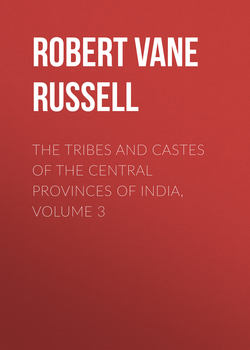Читать книгу The Tribes and Castes of the Central Provinces of India, Volume 3 - Robert Vane Russell - Страница 38
Gond
(c) Marriage Customs
20. Special customs
ОглавлениеSome years ago in Bālāghāt the bride and bridegroom sat and ate food together out of two leaf-plates. When they had finished the bride took the leaf-plates, ran with them to the marriage-shed, and fixed them in the woodwork so that they did not fall down. The bridegroom ran after her, and if she did not put the plates away quickly, gave her one or two blows with his fist. This apparently was a symbolical training of the bride to be diligent and careful in her household work. Among the Rāj-Gonds of Saugor, if the bridegroom could not come himself he was accustomed to send his sword to represent him. The Sawāsin carried the sword seven times round the marriage-post with the bride and placed a garland on her on its behalf, and the bride put a garland over the sword. This was held to be a valid marriage. In a rich Rāj-Gond or Khatola Gond family two or three girls would be given with the bride, and they would accompany her and become the concubines of the bridegroom. Among the Māria Gonds of Chānda the wedded pair retire after the ceremony to a house allotted to them and spend the night together. Their relatives and friends before leaving shout and make merry round the house for a time, and throw all kinds of rubbish and dirt on it. In the morning the couple have to get up early and clear all this off, and clean up the house. A curious ceremony is reported from one part of Mandla. When a Gond girl is leaving to be married, her father places inside her litter a necklace of many strings of blue and yellow beads, with a number of cowries at the end, and an iron ring attached to it. On her arrival at the bridegroom’s house his father takes out the necklace and ring. Sometimes it is said that he simply passes a stone through the ring, but often he hangs it up in the centre of a room, and the bridegroom’s relatives throw stones at it until one of them goes through the ring, or they throw long bamboo sticks or shoot arrows at it, or even fire bullets from a gun. In a recent case it is said that a man was trying to fire a bullet through the ring and killed a girl. Until a stone, stick, arrow or bullet has been sent through the ring the marriage cannot take place, nor can the bridegroom or his father touch the bride, and they go on doing this all night until somebody succeeds. When the feat has been done they pour a bottle of liquor over the necklace and ring, and the bride’s relatives catch the liquor as it falls, and drink it. The girl wears the necklace at her wedding, and thereafter so long as her husband lives, and when he dies she tears the string to pieces and throws it into the river. The iron ring must be made by a Gondi Lohār or blacksmith, and he will not accept money in payment for it, but must be given a cow, calf, or buffalo. The symbolical meaning of this rite does not appear to require explanation.63 In many places the bride and bridegroom go and bathe in a river or tank on the day after the wedding, and throw mud and dirt over each other, or each throws the other down and rolls him or her in the mud. This is called Chikhal-Mundi or playing in the mud. Afterwards the bride has to wash the bridegroom’s muddy clothes, roll them up in a blanket, and carry them on her head to the house. A see-saw is then placed in the marriage-shed, and the bridegroom’s father sits on it. The bride makes the see-saw move up and down, while her relations joke with her and say, ‘Your child is crying.’ Elsewhere the bridegroom’s father sits in a swing. The bride and bridegroom swing him, and the bystanders exclaim that the old man is the child of the new bride. It seems possible that both customs are meant to portray the rocking of a baby in a cradle or swinging it in a swing, and hence it is thought that through performing them the bride will soon rock or swing a real baby.
63
The above rite has some resemblance to the test required of the suitors of Penelope in the Odyssey of bending the bow of Odysseus and shooting an arrow through the axes, which they could not perform.
